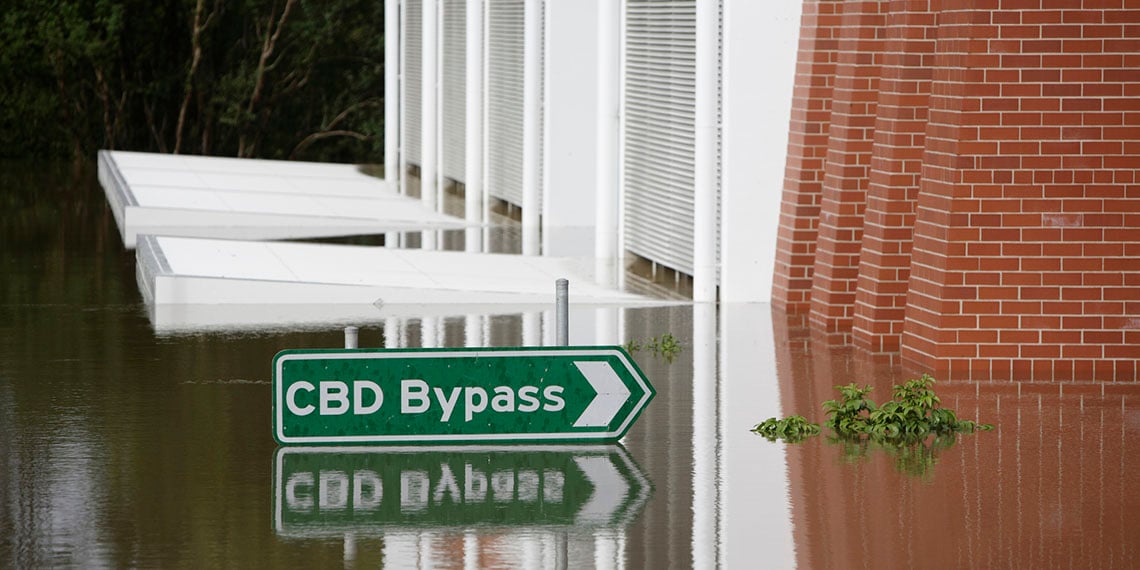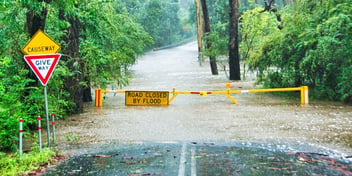Flood frontlines in Lismore: what needs to change

The water community must move past historical data and focus on future risks for flood planning, says a leading figure in Lismore’s flood plain management efforts.
Engeny Water Management Director and Government Sector Leader Mark Page said the intensity of the recent flooding events highlight the need to take a risk-based approach to management and mitigation, and to recognise that historical data provides a limited benefit in predicting future events under a changing climate.
“A risk-based approach means understanding the risks for a range of flood events for the locality that we are trying to manage. It’s also about understanding the vulnerabilities within the area and being clear on the objectives,” he said.
“What is the risk to people, property and infrastructure? Are we aiming to reduce the risk through the use of engineering measures, like levees and dams, or remove the risk through land use planning and other non-engineering solutions, like floodplain retreat, or a combination of both?
“But, crucially, it’s also about recognising that you never know how big the next real event will be, how often these events will occur, and it is important not to rely on historical events.
“We need to move away from focusing on one-in-100 annual exceedance probability (AEP) events, or the largest historical event on record. A lot of towns do that, but the Lismore floods have taught us very clearly that there are going to be bigger events.”
Page said modelling is often based on theoretical events derived using historical data, and development planning is based on a defined flood event or flood planning level – usually 1:100 AEP plus 500mm freeboard.
“This is often state government policy but needs to be reconsidered, particularly for vulnerable towns such as Lismore. Council’s need to play a greater role in managing flood risk and defining suitable controls based on existing and future risks,” he said.
“With the uncertainties associated with the climate and rainfall events; we may be aiming at a target that is going to move. We need to foster a much broader perspective on how flood risk is managed, rather than just focusing on isolated events or pre-defined flood levels."
Measuring up
Having worked alongside Lismore City Council and Rous County Council to develop an updated hydrologic and hydraulic model, and assess flood behaviour over the past few years, Engeny Water Management is about to launch an in-depth analysis of the rainfall across the catchment for the 2022 events, alongside the NSW Government.
Page said this work is needed to be able to properly characterise the flood event, but that it is already very clear that the rainfall that occurred across the catchment has a low Annual Exceedance Probability, with initial estimates suggesting the event is between a 1:1000 and 1:3500 AEP.
“There were parts of the northern rivers region that received incredible amounts of rainfall. The Wilsons River catchment received more than 800 millimeters on average between the 24th and 28th February and Dunoon, for example, received over 700mm in 24 hours to Monday 28th February, which is understood to be the second highest daily total on record for NSW,” he said.
“The Wilsons River catchment has a contributing runoff area of nearly 1400 square kilometers, so the February 2022 rainfall generated an unbelievable amount of floodwater. The Wilsons River channel width through Lismore is roughly 80m, and the extent of inundation across the floodplain was approximately five kilometers in the February 2022 event.
“The February 2022 event was nearly 2m higher than the 1:100 AEP design flood level, nearly 1.4m higher than the 1:500 AEP design flood level, and 2.3m higher than the 1954 and 1974 events, which were previously the largest events on record.”
Page said Lismore’s floodplain presents particular challenges – not only is it flood prone, but the way the town is situated in the floodplain and interacts with the waterways leaves a significant part of Lismore highly vulnerable.
“Lismore sits right at the confluence of Leycester Creek and Wilsons River. Leycester Creek has a slightly larger catchment than the Wilsons River, and Leycester Creek also breaks out through South Lismore. The two catchments combine at Lismore,” he said.
“Not only have you got the confluence where Wilsons River and Leycester Creek combine, you've also got a significant isolation risk to South Lismore as evacuation requires crossing the river. For this reason, early evacuation from South Lismore is critical as it becomes isolated before other parts of Lismore.”
Page said this poses a significant challenge to flood risk management in the area for larger events, particularly when low-level levees are utilised as a key defense, and that levees can lead to a level of complacency in terms of community response including evacuation.
“The challenge in terms of identifying suitable engineering solutions for flood risk reduction for Lismore is the fact that there are likely to be negative impacts to areas that don’t benefit from a structural solution,” he said.
“For example, you've got the Lismore CBD levee, which was designed to provide protection to the CBD for events up to the 1:10 AEP design flood level. If you raise the CBD levee, you're displacing water to South Lismore and North Lismore by creating an obstruction above the current levee height, which removes storage in the floodplain that is currently provided by the CBD.
“This forces floodwater across to South Lismore which also impacts North Lismore. Therefore, there would need to be measures to mitigate the increased risk to impacted areas.”
Page said there are a number of towns in Australia where a levee provides the only means of protection during an event and, for many of those towns, levees have generally worked extremely well for the flood events they were designed for.
“But the problem with the levee is it doesn't completely remove the risk; it only reduces the risk as the levee becomes redundant once it is overtopped. There can also be environmental and social implications associated with the introduction or modification of levees that should be considered,” he said.
“Levees can be a valuable form of risk reduction but should be considered in combination with other engineering and non-engineering measures including, but not limited to, land use and development control, floodplain retreat/house purchase, floodproofing of buildings, and emergency response planning.
“The reality is that the recent February flood event was 2m above historic flooding. If you build the levee above 14.4m, which was the peak in Lismore, in the future there will be a flood event bigger than the one that we've just had.
“I am supportive of levees, but they don’t completely remove the risk, unfortunately, and they can instead introduce complacency and in some cases promote further development in a floodplain.”
Leveling risk
Page said any future solution for Lismore must take a multi-pronged approach, where engineering solutions introduced to protect the CBD are coupled with other measures to manage the risk outside the CBD at North and South Lismore.
“If the CBD is the only focus, then a levee rise is possible. But there needs to be other measures to manage the negative impact associated with the levee,” he said.
“There are also environmental and social impacts that need to be considered as well, including social considerations in terms of the impacts to properties that aren't protected by a raised CBD levee and aren’t removed from the floodplain.”
While damming has been suggested as a potential option, Page said building a dam still poses similar limitations to raising levees – when there are extreme amounts of rainfall that exceeds the designed mitigation volume, there are limits to the benefit the solution will provide.
“A flood mitigation dam can provide a tangible benefit for flood mitigation purposes. Wivenhoe Dam is a good example where a dam with a significant flood storage volume can provide a substantial mitigation benefit, provided the flood storage is available when it is required,” he said.
“But, following the Lismore flooding in February, you'd have to question how much volume is going to be available in a flood mitigation dam for the rainfall burst that occurred at the back end of the rainfall event.
“This emphasises the fact that engineering solutions alone don't completely remove the risk. They can reduce the risk, but in significant events like the one that we've just had, there aren't many engineering solutions that are going to completely mitigate the risks associated with those events.”
Moving forward
Page said one option for Lismore moving forward is to consider rezoning some areas and providing government subsidies to buy back land to facilitate floodplain retreat, but this approach also brings economic and social challenges.
“There has been a scheme in place for Lismore where a limited number of residents have received funding assistance to raise houses that had a higher risk. But I think this event has shown the limitation of solutions that are based on a defined height,” he said.
“In the case of South Lismore and North Lismore, people are at risk and some lives were lost in the recent February event. There needs to be a commitment to remove as many residents as possible from the floodplain. And this is a very challenging thing to do on a large scale.
“While rezoning some areas to non-residential and providing government subsidies for relocation is one way to go about it, a lot of people in Lismore don't have the financial means to be able to take up that subsidy and get something equivalent or better than what they've already got.
“There would need to be a solid commitment from government to provide the financial support to achieve this.”
Page said the challenge is to get the necessary funding and support to provide a solution that provides enough of an incentive for people to relocate out of the floodplain.
“Most importantly, the solutions that are devised for Lismore need to be supported by all levels of government,” he said.
“There's no silver bullet that will solve Lismore’s flooding challenges in an instant and a combination of engineering and non-engineering measures will be required, however, the amount of future funding will certainly impact the options that are available.”

